- DOI 10.31509/2658-607x-202363-133
QUALITY OF TREE LITTER AS AN INFORMATIVE INDICATOR OF FUNCTIONAL CLASSIFICATION OF FORESTS
Original Russian Text © 2022 E. V. Basova, N. V. Lukina, A. I. Kuznetsova, A. V. Gornov, N. E. Shevchenko, E. V. Tikhonova, A. P. Geraskina, T. Yu. Braslavskaya, D. N. Tebenkova, D. L. Lugovaya published in Forest Science Issues Vol. 5, No 3, Article 113.
E. V. Basova, N. V. Lukina, A. I. Kuznetsova, A. V. Gornov, N. E. Shevchenko, E. V. Tikhonova, A. P. Geraskina, T. Yu. Braslavskaya, D. N. Tebenkova, D. L. Lugovaya
Center for Forest Ecology and Productivity of the RAS
Profsoyuznaya St. 84/32 bldg. 14, Moscow, 117997, Russia
E-mail: lenabasova7@gmail.com
Received: 01.09.2022
Revised: 17.10.2022
Accepted: 18.11.2022
Relevance and goals. In the context of global climate change, the climate-regulating function of forests deserves special attention. There is still no functional classification of forests according to the effectiveness of carbon accumulation function. The aim of this paper is to discuss an approach to such classification based on the assessment of tree litter quality.
Objects and methods. To test the approach to the identification of functional types of forests based on the quality of tree litter, taking into account the location in the geochemically linked landscape and the mechanical composition of soil-forming rocks, data on soils and vegetation obtained at 23 testing sites in the subzone of coniferous-broadleaf forests of the European part of Russia on the territory of Bryansk Polesie and Moskvoretsko-Okskaya plain were used. For indirect (Landolt’s ecological scales using the SpeDiv program) assessment of differences in the soil richness in forests belonging to different functional types, the species composition at 160 geobotanical plots in forest sites in the Moscow, Bryansk, Smolensk, Kostroma Regions, Krasnodar Territory, and the Republic of Adygea (Northwestern Caucasus) were analyzed.
Results. Examples of functional forest types for coniferous — broad-leaved forests of the European part of Russia are given. The differences in soil carbon stock between forests belonging to different functional types were found, and a preliminary assessment of the influence of the location in the geochemically linked landscape and the mechanical composition of soils on the accumulation of carbon in soils in the same functional forest types is given.
Conclusion. Based on the quality of the tree litter, 15 functional forest types were identified, which are confirmed by examples of forests in the subzone of coniferous-broad-leaved forests of the European part of Russia and in the belt of coniferous-broad-leaved forests of the Northwestern Caucasus. The validity of identification of functional forest types for the efficiency of carbon accumulation in soils based on the quality of tree litter, taking into account the influence of “external factors” (the location of forests in the geochemically linked landscape and the mechanical composition of soil-forming rocks), was confirmed by data obtained at 23 sites. Using this approach allowed us to reveal differences in the soil carbon stock and related characteristics of soil fertility estimated on an ecological scale between the functional forest types, identified on the base of tree litter in the mixed, coniferous-broad-leaved forests at the same location in the geochemically linked landscape. Differences in soil carbon stocks in forest ecosystems of the same functional forest types formed on clay loam and sandy loam soil-forming rocks were also revealed. Differences in soil carbon stocks in forests belonging to the same functional type, but formed at different locations in the geochemically linked landscape, have been confirmed: soil carbon stocks were higher in forests at the transit landscapes compared to those in autonomous ones.
Keywords: coniferous-broad-leaved forests, forest functional classification, functional types of forests, carbon stocks
Currently, attention is being increasingly focused on the forest ecosystem functions and services. Forests perform ecosystem functions/services of all four categories: regulating, providing supporting and cultural (Millennium Ecosystem Assestment, 2005). In this regard, it becomes important to develop new approaches to the functional classification of forest ecosystems based on the effectiveness of their various functions (Lukina et al., 2021).
In the context of global climate change associated with an increase in greenhouse gas emissions into the atmosphere, the climate-regulating function of forests deserves special attention. Forests can absorb greenhouse gases and store carbon in both biomass and soil pools. A number of studies have shown that the effectiveness of forests in performing the function of carbon accumulation, in particular carbon accumulation in the soil, can be influenced by various natural and anthropogenic factors (Mazhitova et al., 2003; Chestnyh et al., 2004; Mashika, 2005; Shchepashchenko et al., 2013; Bobkova et al., 2014; Baeva et al., 2017; Telesnina et al., 2017; Bakhmet, 2018; Dymov, 2018; Demakov et al., 2018; Chestnyh et al., 2020; Ryzhova et al., 2020; Akkumuljacija …, 2018; Lukina et al., 2020; Kuznetsova et al., 2021). Internal and external factors can be distinguished among natural factors. Internal factors include vegetation, soil microorganisms and animals, and other biota; external factors include abiotic factors such as soil-forming rocks, climate, and relief. Among anthropogenic factors, the regime of forest management and land use in general, the pollution-induced factor, and fires are important.
Vegetation as the main source of organic matter entering the soil determines the level of accumulation of soil organic matter. The dynamics of soil carbon pools caused by vegetation are influenced by the quantity and quality of tree species litter, both individually and jointly (Castellano et al., 2015; Kuznetsova et al., 2021).
The quality of the litter depends on the species composition and age structures of forest trees, as well as the stages of tree plant ontogenetic development, and is determined by the ratio of nutrients (nitrogen, phosphorus, potassium, calcium, magnesium, etc.) and secondary metabolites (polyphenols, lignin, etc.) in the litter; an important indicator is the C/N ratio (Berg, 2020). The quality of the litter regulates the rate of decomposition of plant residues — the main source of nutrients for saprophages (Krishna, 2017). According to the quality of the litter, functional types of plants can be distinguished (Cornelissen et al., 2007).
The functional classification of forest ecosystems according to the effectiveness of their carbon cycle regulation can be based on the quality of plant litter (Lukina et al., 2021). In coniferous-broad-leaved forests, a significant proportion of plant litter, which decisively affects the accumulation of soil carbon, is formed by tree plants. Low-quality litter, that is, with a low content of bases, nitrogen, high acidity, high content of lignin, and other secondary metabolites, as well as a wide C/N ratio, is characteristic of coniferous trees. Earlier, when comparing coniferous tree species with each other, it was noted that the litter in pine forests differed in a much wider C/N ratio than in spruce forests (Lukina et al., 2020). A number of studies of European (Lovett et al., 2004; Reich et al., 2005; Oostra et al., 2006) and North American (Finzi et al., 1998; Neirynck et al., 2000; Dijkstra, Fitzhugh, 2003; Hagen-Thorn et al., 2004) scientists showed differences in the litter quality , C stocks and C/N ratio between some broad-leaved forests forming by different tree species (Fraxinus exelsior, Fagus orientalis and the genera Acer and Quercus): ash and maple are grouped into plants with high litter quality, while oak and beech are characterized by a relatively low N content in the litter, a wider C/N ratio, low decomposition rate.
The aim of this paper is to discuss the results of the implementation of an approach to the functional classification of coniferous-broad-leaved forests based on the relationships between the quality of tree litter and carbon stocks in soils.
At this stage of the work, we raised the scientific tasks as follows:
- to determine which functional types of forests can be identified on the basis of tree litter quality in coniferous-broad-leaved forests of the European part of Russia;
- to find out whether the functional types of forests identified on the basis of the proposed approach differ in terms of soil carbon stocks;
- to demonstrate the influence of location in the geochemically linked landscape of forest ecosystems belonging to the same functional forest types (FFT) and of soil forming rocks on carbon accumulation in soils.
MATERIALS AND METHODS
The analysis includes data on geobotanical descriptions of forest communities and soil characteristics of 23 sites representing forests in autonomous and transit locations in landscapes on soil-forming rocks of different mechanical compositions (sandy loam, clay loam) in the subzone of coniferous-broad-leaves forests of the European part of Russia. On loamy soil-forming rocks of the Moskvoretsko-Okskaya plain (MO), oak-spruce forests with lime and boreal-nemoral herbs were studied. On the sandy Bryansk forest area (BFA), polydominant broad-leaved forests with spruce and nemoral herbs, pine forests with dwarf shrubs and green mosses, and aspen-birch nemoral forests were studied.
Geobotanical descriptions were performed on 20×20 m permanent sample plots according to the standard methodology (Akkumuljacija …, 2018). Samples from the soil mineral horizons using a soil drill below and between the trees, and soil samples were taken up deeper, to a depth of 100 cm between the trees manually, using a shovel. Litter samples were taken at sites 0.25×0.25 m. All sample plots were established in triplicate. In the laboratory, samples from mineral horizons were dried and sieved through a 2 mm sieve, chemical analysis was carried out in samples of a fraction less than 2 mm. Litter samples were dried and weighed to determine the stock (Akkumuljacija …, 2018). The carbon and nitrogen content in all samples was determined using a CHN analyzer (EA 1110 (CHNS-O)).
An indirect assessment of the soil fertility in forests belonging to different FFTs was carried out on the Landolt ecological scale using the SpeDiv program, the species compositions of 160 geobotanical plots of forest vegetation in the Moscow, Bryansk, Smolensk, Kostroma Regions, Krasnodar Territory, and the Republic of Adygea (Northwestern Caucasus) were analyzed.
The inventory of forest communities within the identofied FFTs was based on the materials of Forest cenofond within European Russia (Cenofond …, 2010), for the Northwestern Caucasus — based on the materials of the original database of geobotanical descriptions of forest communities of the Northwestern Caucasus (by Shevchenko) and published data (Francuzov, 2006).
RESULTS AND DISCUSSION
Based on the quality of the litter, the plants of the tree layer were divided into 4 main functional groups:
- deciduous trees with fast decomposing litter (these include species of the genera Acer, Fraxinus, Tilia, Ulmus, Betula, Alnus);
- deciduous trees with slow-decomposing litter (Populus, Quercus, Fagus);
- dark coniferous trees (Picea /Abies);
- light coniferous (Pinus).
Based on data from the Forest cenofond within European Russia (Cenofond …, 2010), up to 160 different taxonomic forest types can be identified in the subzone of coniferous-broad-leaved forests of European Russia. The tree layer of these forests can be monodominant, particularly at the early stages of natural succession or on plantations, but more often in the tree layer of forests of the subtaiga subzone, various species belonging to different functional groups in terms of the quality of litter are combined. In this regard, all the variety of forest taxonomical types found in the subzone of coniferous-broad-leaved forests of the European part of Russia can be attributed to 15 main functional types (Table 1), identified on the basis of the quality of plant litter affecting the level of carbon accumulation in the soil (Akkumuljacija …, 2018; Lukina et al., 2021; Kuznetsova, 2022). In the coniferous-broad-leaved forests of the Northwestern Caucasus, secondary after-logging communities with significant contribution of small-leaved tree species (hornbeam, alder, aspen, etc.) are developed over large areas. Old-age intact forests are formed, as a rule, by spruce, oak, beech, and fir (Akkumuljacija …, 2018). Based on the quality of the tree litter in the Northwestern Caucasus, 14 functional types of forest were identified.
Table 1. Functional forest types (FFTs) and their corresponding groups of forest types in the subzone of coniferous-broad-leaved forests of the European part of Russia and in the belt of coniferous-broad-leaved forests of the Northwestern Caucasus
| FFFT | Tree layer composition | Groups of forest types in the plains of the European part of Russia (according to Cenofond …, 2010) | Types of forest, Northwestern Caucasus |
| AA1 | Deciduous species with fast decomposing litter predominate* | Birch forests small-herb boreal, nemoral, nitrophilic and mesotrophic-marsh, lime forests and gray alder forests nemoral and nitrophilic, black alder forests and ash forests nitrophilic | Hornbeam forests fescue, mixed herbs, honeysuckle-mixed herbs; alder forests ferns-tall herb |
| AA2 | Deciduous species with slow-decomposing litter predominate | Oak, aspen-oak nemoral and nitrophilic; aspen boreal nemoral, nemoral and nitrophilic | Beech forests mountain fescue, oak-beech forests mixed herbs (bedstraw) |
| AA3 | Dark coniferous species predominate | Spruce forests dwarf-shrub and small-herb green-moss, small-grass-boreal, boreal-nemoral and nemoral; fir-spruce forests boreal-nemoral | Fir forests oxalis, mixed grass (bedstraw), mixed herbs-ferns, mixed herbs-mountain fescue, oxalis-small-grass;
spruce-fir forests oxalis-small-grass |
| AA4 | Light coniferous species predominate | Pine forests green-moss-lichen, xerophytic-dwarf-shrub- and small-herb green-moss, small-herb-boreal and nemoral, haircap-moss-sphagnum | Pine forests with rhododendron, cereal (reed grass) |
| AA5 | ** Dark coniferous and deciduous species with fast decomposing litter are combined | Spruce forests with lime and maple nemoral and boreal-nemoral, fir-spruce with lime boreal-nemoral, spruce with birch dwarf-shrub green-mossy, birch with spruce small-herb boreal and nemoral, lime with spruce nemoral and nitrophilic | Fir-hornbeam forests with rhododendron,
fir-hornbeam forests with Pachyphragma; hornbeam forests with fir, small-grass with raspberry |
| AA6 | Dark coniferous and deciduous with slow-decomposing litter are combined | Oak-spruce and spruce-oak nemoral and small-herb boreal | Beech-fir forests with Pachyphragma, mixed-herbs, dead cover; fir-beech forests oxalis-small-herbs |
| AA7 | Light coniferous and deciduous species with fast decomposing litter are combined | Pine forests with lime nemoral and boreal-nemoral, pine forests with birch nemoral and dwarf-shrub green-moss | Hornbeam-pine forests rhododendron-fescue |
| AA8 | Light coniferous and deciduous species with slow-decomposing litter are combined | Pine forests with oak xerophytic green-moss, boreal-nemoral; complex pine forests boreal-nemoral | Beech-pine forests with rhododendron |
| AA9 | Deciduous species with slow- and fast-decomposing litter are combined | Birch-aspen with lime, aspen with lime, elm-lime-oak, lime-oak, lime-oak with ash, oak-lime, aspen-lime nemoral; oak with black alder nitrophilic | Hornbeam-beech forests mixed-herbs, mixed-herbs-blackberry;
hornbeam-aspen forests mixed-herbs; aspen-hornbeam forests mixed-herbs; oak-hornbeam forests fescue; aspen-hornbeam forests ferns-mixed-herbs, honeysuckle-small-grass, bedstraw; hornbeam forests with aspen, beech, and ash |
| AA10 | Dark coniferous and light coniferous species are combined | Pine forests with spruce xerophytic, dwarf-shrub and small-herb green-moss, haircap-moss sphagnum | Pine forests with fir and spruce nemoral mixed-herb; pine forests with fir reed grass-mixed-herb |
| AA11 | Dark coniferous and deciduous species with fast- and slow-decomposing litter are combined | Lime-oak with spruce, oak-lime with spruce, spruce forests with lime and oak nemoral; oak-spruce with maple boreal-nemoral | Beech-fir-hornbeam forests honeysuckle-mixed-herbs |
| AA12 | Dark coniferous, light coniferous and deciduous species with fast decomposing litter are combined | Pine forests with spruce and birch dwarf-shrub green-moss, xeromesophilic- herbaceous, small-herb boreal | Pine forests with spruce, fir, and birch reed grass |
| AA13 | Dark coniferous, light coniferous and deciduous species with slow-decomposing litter are combined | Pine forests with aspen and spruce dwarf-shrub and green-moss, spruce forests with pine and oak (aspen) small-grass and green-moss | Pine-aspen-fir forests reed grass; pine forests with spruce, fir and aspen legumes-mixed herbs; pine forests with fir and beech rhododendron-dead cover |
| AA14 | Light coniferous and deciduous species with fast- and slow-decomposing litter are combined | Complex pine forests boreal-nemoral, pine forests with birch and aspen dwarf-shrub and green-moss | Pine-beech-hornbeam forests blackberry |
| AA15 | Light coniferous, dark coniferous and deciduous species with fast- and slow-decomposing litter are combined | Pine with spruce (with birch, lime, and oak) xeromesophilic-herbaceous, spruce with pine (with birch and aspen, oak) small-herb boreal | Not identified |
* Here and further — the share of the predominant species in the total tree layer — is more than 90%;
** In the tree layer, species can be combined in a fairly wide range of ratios for the cover (50/50%, 90/10%).
As it is known, nitrogen and carbon are closely related in organic matter, and the ratios between them are tissue-specific and species-specific. The conjugacy of nitrogen and carbon content in the soil of European part of Russia was also confirmed earlier in a number of our works (Akkumuljacija …, 2018; Kuznetsova et al., 2021). Based on this, for an indirect assessment of the effectiveness of the function of carbon accumulation in soils by forests belonging to different FFTs, a characteristic of nitrogen richness in soil was used, obtained on the basis of an analysis of species composition on the Landolt scale of soil richness. The geobotanical descriptions of the mountain forests of the Northwestern Caucasus and lowland forests of European Russia, attributed to the same FFT, were analyzed (Fig. 1).
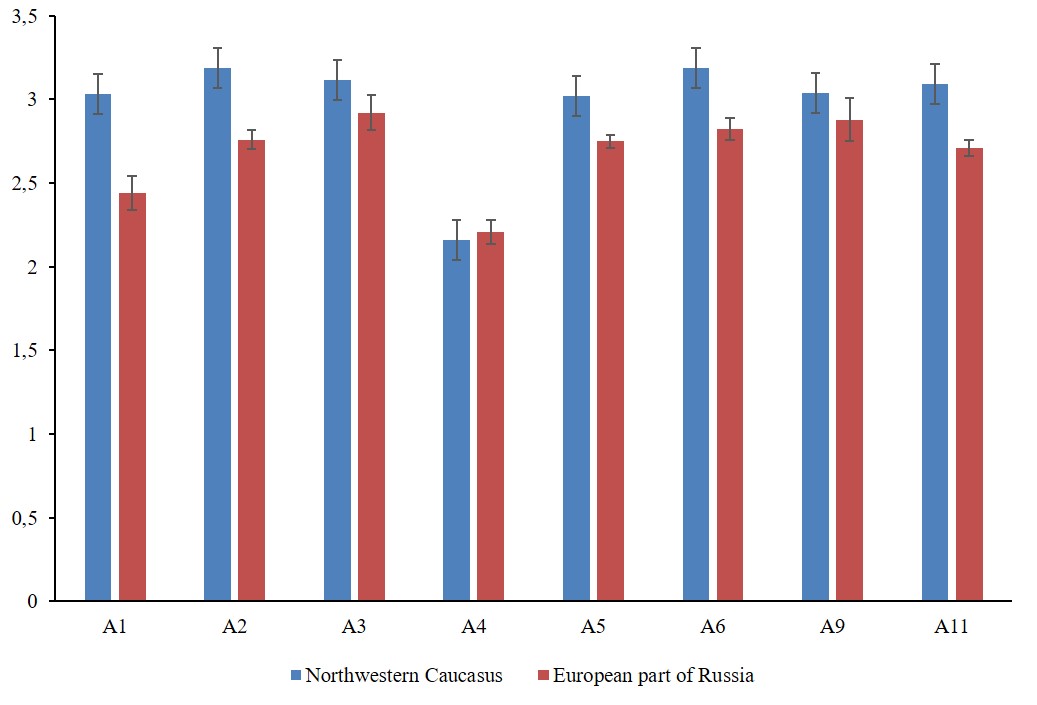
Figure 1. The richness of the soil with nitrogen (Landolt indicator values). The x-axis signatures represent the functional types of the forest (see Table 1).
Note: The histogram is based on the average values of soil richness points based on the analysis of 160 geobotanical descriptions (10 descriptions for each functional type).
In the Northwestern Caucasus, the values of soil richness were higher in all FFTs except for A4 (light coniferous forests). The A4 type has the lowest values of soil richness for both the Northwestern Caucasus and the plains of the European part; the difference in values between the two regions was also minimal for this type. Despite the fact that the values of soil richness in forest ecosystems belonging to the same FFT differ in the regions, which was explained by differences in climatic, soil, and orographic conditions, both in the Northwestern Caucasus and on the plains of the European part of Russia, there is a similar tendency for soil richness indicators to change from type to type, which confirms the key role of vegetation and the quality of plant litter in the accumulation of organic matter in the soil.
Direct soil measurements were performed for forests belonging to functional types A4 (pine forests), A9 (mixed type, in layer A, deciduous tree species with slow and rapidly decomposing litter are combined) formed on sandy loam soils in the Bryansk forest area and A11 (mixed forests: in the tree layer, dark coniferous and deciduous species with fast- and slow-decomposing litter), growing in the Bryansk forest area, as well as on loams on the Moskvoretsko-Okskaya plain. Figure 2 shows the contribution of species of different functional groups in the tree layer cover of these 3 FFTs.
(a)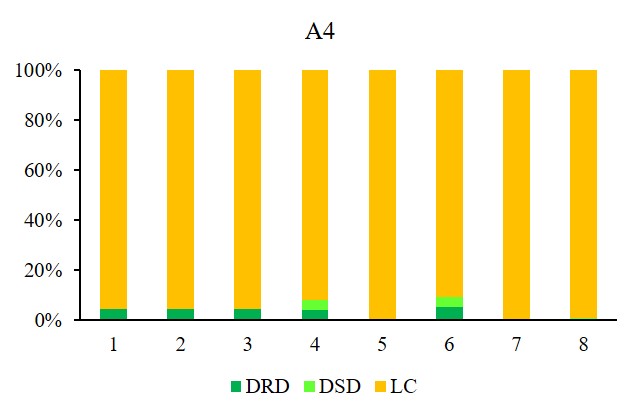
(b)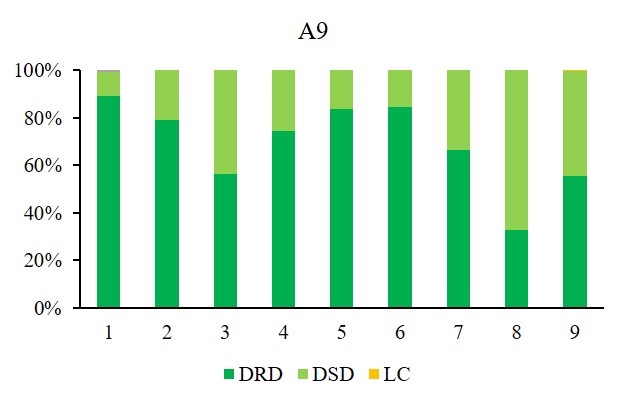
(c)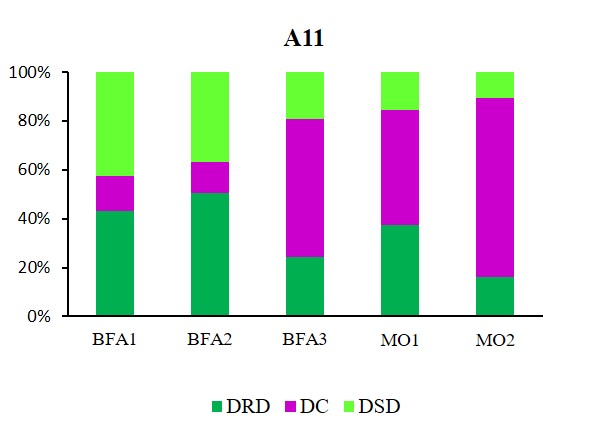
Figure 2. The ratio of the cover of tree species of different functional groups (DRD — deciduous trees with rapidly decomposing litter, DSD — deciduous trees with slowly decomposing litter, DC — dark coniferous trees, LC — light coniferous trees) in layer A in forests of functional types A4 (a), A9 (b), and A11 (c). On X-axis for a, b: ordinal numbers of sites; for c: BFA (1–3) — sites in the Bryansk forest area, MO (1–2) — sites on the Moskvoretsko-Okskaya plain
In forests of A4 type, 90% of the tree layer cover was composed by light coniferous species (in this case Pinus sylvestris), in forests of A9 type deciduous trees of different functional groups were combined in different proportions.
In A11 forests, the contribution in the tree layer of trees of dark coniferous species (DC), deciduous with rapidly (DRD) and slowly decomposing (DSD) litter was different.
Soil measurements in the forests of the Bryansk forests, forming in similar landscape location and climatic conditions on soil-forming rocks of similar composition, also revealed a difference in the soil carbon stocks between the forests belonging to different FFTs (Fig. 3, 4).
(a)
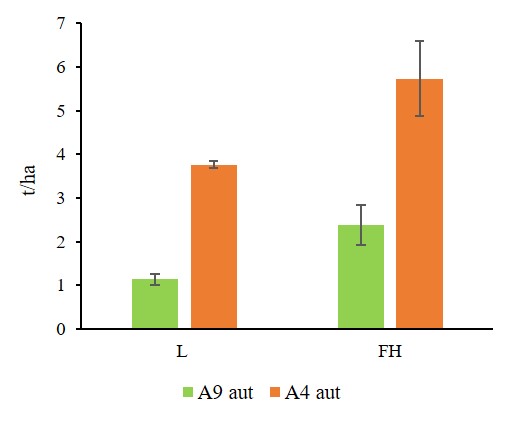
(b)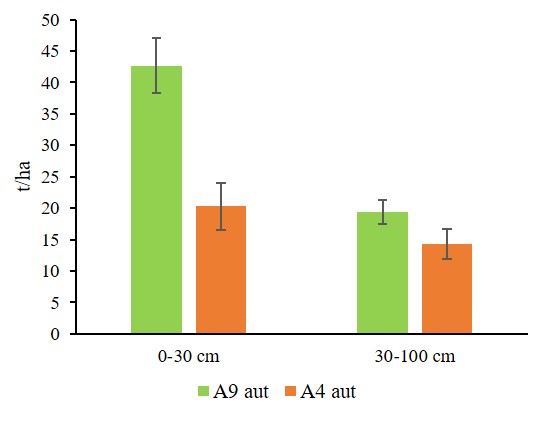
Figure 3. Carbon stock in the forest litter (a) and the mineral layer of the soil (b) in forest ecosystems of functional types A9 and A4 in autonomous landscapes, t/ha. On X-axis: L, FH — litter subhorizons, 0–30 cm, 30–100 cm — soil layers (mineral part)
(a)
(b)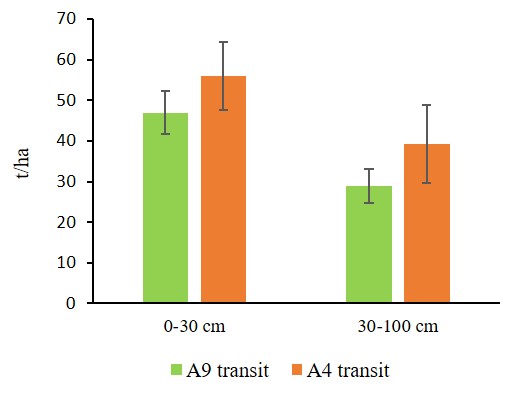
Figure 4. Carbon stock in the forest litter (a) and the mineral layer of the soil (b) in forest ecosystems of functional types A9 and A4 in transit landscapes, t/ha
In autonomous landscapes, the carbon stock in litter of aspen-birch forests (FFT A9) and pine forests (FFT A4) demonstrated some differences (p = 0.05) for both the L and the FH litter subhorizons, in the mineral profile the differences were also found in the upper (0–30 cm) layer (p = 0.05) (Fig. 4 (b)): carbon stock in the litter of A4 pine forests was higher, in soil mineral horizons, on the contrary, carbon stock was higher in A9 (Fig. 3 (b)).
In transit landscapes, carbon stock demonstrated significant differences between the two FFTs only in the FH subhorizon (p = 0.008), whereas no significant differences were found in the mineral profile (Fig. 4).
The influence of the mechanical composition of soil-forming rocks and location of forest in the geochemically linked landscape on the function of carbon accumulation in the soil of forests belonging to the same FFT has also been assessed.
When comparing the soil carbon stock in A9 forests at different landscape locations, no differences were found in carbon stock in mineral layers: the average values of carbon stock were 36.2 t/ha, 6.5 t/ha, and 23.0 t/ha in mineral layers 0–15, 15–30, and 30–100 cm of soil, correspondingly, in autonomous landscape. In transit landscape, soil carbon stock averaged 33.0 t/ha, 13.9 t/ha, and 24.4 t/ha in layers 0–15, 15–30, and 30–100 cm, correspondingly. Perhaps, the lack of statistically significant differences was due to insufficient number of samples.
The expected pronounced differences in soil carbon stock between forests at autonomous and transit landscapes were found in forests of A4 type (light coniferous). In this case, the Mann-Whitney U test has confirmed the reliability of differences between carbon stock in forests formed in different location of geochemically linked landscapes in the soil layer of 0–30 cm and 30–100 cm (p = 0.037): 20.3 t/ha and 14.2 t/ha in transit conditions, respectively, and 55.9 t/ha and 39.2 t/ha in autonomous conditions, respectively.
Carbon stock in soils of A11 functional forest type formed on soil-forming rocks of different mechanical composition in the Bryansk forest area and on the Moskvoretsko-Okskaya plain in similar, autonomous landscapes differ in the litter and mineral layer 0–15 cm (Fig. 5).
(a)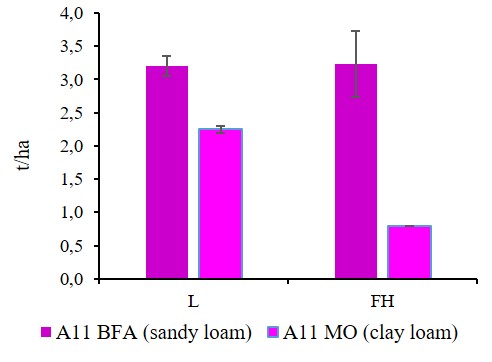
(b)
(c)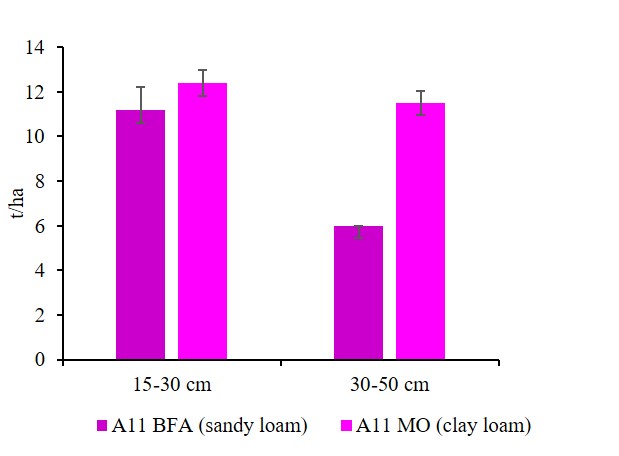
Figure 5. Carbon stock in the forest litter (a) and mineral layers of the soil (b, c) in FFT A11, mt/ha. On the x-axis: L, FH — subhorizons of the litter; 0–15 cm, 15–30 cm, 30–50 cm — soil layers (mineral part)
The carbon stock in the litter (subhorizon FH) was higher in forests on sandy loam soils, whereas in the mineral horizons of soils (in layers of 0–15 cm, 15–30 cm, and 30–50 cm) soil carbon stock was higher in forests on loam. The maximum differences (almost 2 times) were found in the soil layer from 30 to 50 cm, and visible differences were also revealed in the upper part of the mineral layer (0-15 cm).
CONCLUSION
The quality of plant litter is an important factor regulating the accumulation of soil organic matter and the dynamics of soil carbon pools, and can be an informative indicator for classifying forests according to the effectiveness of their carbon cycle regulation function.
In coniferous-broad-leaved forests, a significant proportion of plant litter is formed by tree plants. The quality of tree litter affects the accumulation of soil carbon in the forests of this subzone. Based on the litter quality, the plants of the tree layer can be divided into 4 main functional groups: deciduous trees with rapidly decomposing litter, deciduous trees with slowly decomposing litter, dark coniferous and light coniferous trees.
In the subzone of coniferous-broad-leaved forests, both monodominant and polydominant forest communities are common, where species of different functional groups are combined in the tree layer. Taking into account the various combinations of such species in the forest stands, 15 FFTs have been preliminarily identified. All 15 FFTs were found on the plains of the European part of Russia; almost all similar FFTs were found in the belt of coniferous-broad-leaved forests of the Northwestern Caucasus. This paper only demonstrates the differences in soil carbon stock using direct measurements in forests belonging to different FFTs and also using an indirect assessment of soil richness based on an ecological scale.
The influence of soil-forming rocks on the accumulation of carbon in the soil was confirmed: a difference in soil carbon stock in forests of the same FFT on clay loam and sandy loam soils was found. Differences in soil carbon stock in forests formed at different location in the geochemically linked landscape were also confirmed: in forests of functional type A4 (with a predominance of species of light coniferous trees) of transit landscapes, soil carbon stock was higher than that of autonomous landscape, but in forests of functional type A9 (with a combination of species of deciduous trees with slow and rapidly decomposing litter), the influence of the position in the geochemically linked landscape has not been revealed.
To verify the relationships between the FFT and carbon stocks in soils found in this study taking into account the mechanical composition of soil-forming rocks and forest location in the geochemically linked landscape, it is necessary to continue with using more number of testing forest sites.
FINANCING
The research was carried out as a part of the most important innovative project of national importance “Development of a system for ground-based and remote monitoring of carbon pools and greenhouse gas fluxes in the territory of the Russian Federation, ensuring the creation of recording data systems on the fluxes of climate-active substances and the carbon budget in forests and other terrestrial ecological systems” (Registration number: 123030300031-6).
REFERENCES
Akkumuljacija ugleroda v lesnyh pochvah i sukcessionnyj status lesov (Carbon accumulation in forest soils and the successive status of forests), Lukina N. V. (Ed.), Moscow: KMK, 2018, 232 p.
Baeva Ju. I., Kurganova I. N., Pochikalov A. V., Kudejarov V. N., Fizicheskie svojstva i izmenenie zapasov ugleroda seryh lesnyh pochv v hode postagrogennoj jevoljucii (jug Moskovskoj oblasti) (Physical properties and changes in carbon stocks of gray forest soils during postagrogenic evolution (South of the Moscow region), Pochvovedenie, 2017, No 3, pp. 345–353.
Bakhmet O. N., Zapasy ugleroda v pochvah sosnovyh i elovyh lesov Karelii (Carbon reserves in the soils of pine and spruce forests of Karelia), Lesovedenie, 2018, No 1, pp. 48–55.
Berg B., McClaugherty C., Plant Litter, 4th ed. Switzerland, Cham: Springer, 2020, 332 p.
Bobkova K. S., Mashika A. V., Smagin A. V., Dinamika soderzhanija ugleroda organicheskogo veshhestva v srednetaezhnyh el’nikah na avtomorfnyh pochvah (Dynamics of the carbon content of organic matter in middle taiga spruce forests on automorphic soils), Saint-Petersburg: Nauka, 2014, 270 p.
Castellano M. J., Mueller K. E., Olk D. C., Sawyer J. E., Six J., Integrating plant litter quality, soil organic matter stabilization, and the carbon saturation concept, Global change biology, 2015, Vol. 21, No 9. pp. 3200–3209.
Cenofond lesov Evropejskoj Rossii (Forest cenofond within European Russia), 2010, URL: http://cepl.rssi.ru/bio/flora/main.htm (2022, 1 October).
Chestnyh O. V., Grabovskij V. I., Zamolodchikov D. G., Uglerod pochv lesnyh rajonov Evropejsko-Ural’skoj chasti Rossii (Carbon of soils of forest areas of the European-Ural part of Russia), Voprosy lesnoj nauki, 2020, Vol. 3, No 2, pp. 1–15.
Chestnyh O. V., Zamolodchikov D. G., Utkin A. I., Obshhie zapasy biologicheskogo ugleroda i azota v pochvah lesnogo fonda Rossii (Total reserves of biological carbon and nitrogen in the soils of the forest fund of Russia), Lesovedenie, 2004, No 4, pp. 30–42.
Cornelissen J. H., Lang S. I., Soudzilovskaia N. A., During H. J., Comparative cryptogam ecology: A review of bryophyte and lichen traits that drive biogeochemistry, Ann. Bot., 2007, Vol. 99, No 5, pp. 987–1001.
Demakov Ju. P., Isaev A. V., Nureev N. B., Mitjakova I. I., Granicy i prichiny variabel’nosti zapasov gumusa v pochvah lesov Srednego Povolzh’ja (Boundaries and causes of variability of humus reserves in the soils of forests of the Middle Volga region), Vestnik Povolzhskogo gosudarstvennogo tehnologicheskogo universiteta. Serija: Les. Jekologija. Prirodopol’zovanie, 2018, No 3, pp. 30–49.
Dijkstra F. A., Fitzhugh R. D., Aluminum solubility and mobility in relation to organic carbon in surface soils affected by six tree species of the northeastern United States, Geoderma, 2003, Vol. 114, No 1–2, pp. 33–47.
Dymov A. A., Pochvy poslerubochnyh, postpirogennyh i postagrogennyh lesnyh jekosistem severo-vostoka evropejskoj chasti Rossii, Avtoref. diss. kand. biol. nauk (Soils of post-harvest, post-pyrogenic and post-agrogenic forest ecosystems of the north-east of the European part of Russia, Candidate’s biological sci. thesis), Moscow: MGU, 2018, 46 p.
Finzi A. C., Van Breemen N., Canham C. D., Canopy tree–soil interactions within temperate forests: species effects on soil carbon and nitrogen, Ecological applications, 1998, Vol. 8, No 2, pp. 440–446.
Francuzov A. A., Floristicheskaja klassifikacija lesov s Fagus orientalis Lypsky i Abies nordmanniana (Stev.) Spach v bassejne reki Beloj (Zapadnyj Kavkaz) (Dynamics of soil properties and vegetation composition during postagrogenic development in different bioclimatic zones Floristic classification of forests with Fagus orientalis Lypsky and Abies nordmanniana (Stev.) Spach in the Belaya River basin (Western Caucasus), Rastitel’nost’ Rossii, 2006, No 9, pp. 76–85.
Hagen-Thorn A., Callesen I., Armolaitis K., Nihlgård B., The impact of six European tree species on the chemistry of mineral topsoil in forest plantations on former agricultural land, Forest ecology and management, 2004, Vol. 195, No 3, pp. 373–384.
Krishna M. P., Litter decomposition in forest ecosystems: a review, Energy, Ecology and Environment, 2017, Vol. 2, No 4, pp. 236–249.
Kuznetsova A. I., Vlijanie rastitel’nosti na zapasy ugleroda v pochvah dominirujushhih hvojno-shirokolistvennyh lesov evropejskoj chasti Rossii, Diss. kand. biol nauk (The influence of vegetation on carbon stocks in the soils of the dominant coniferous-deciduous forests of the European part of Russia, Diss. cand. biol science), Moscow: Institut lesovedenija RAN, 2022, 130 p.
Kuznetsova A. I., Geraskina A. P., Lukina N. V., Smirnov V. Je., Tihonova E. V., Gornov A. V., Shevchenko N. E., Teben’kova D. N., Ruchinskaja E. V., Vlijanie bioticheskih i abioticheskih faktorov na zapasy pochvennogo ugleroda v lesah (Influence of biotic and abiotic factors on soil carbon stocks in forests), In: Bioraznoobrazie i funkcionirovanie lesnyh jekosistem (Biodiversity and functioning of forest ecosystems), Lukina N. V. (Ed.). Moscow: Tovarishhestvo nauchnyh izdanij KMK, 2021, pp. 131–152.
Lovett G. M., Weathers K. C., Arthur M. A., Schultz J. C., Nitrogen cycling in a northern hardwood forest: do species matter, Biogeochemistry, 2004, Vol. 67, No 3, pp. 289–308.
Lukina N. V., Geraskina A. P., Kuznetsova A. I., Smirnov V. Je., Gornov A. V., Shevchenko N. E., Tihonova E. V., Teben’kova D. N., Basova E. V., Funkcional’naja klassifikacija lesov: aktual’nost’ i podhody k razrabotke (Functional classification of forests: relevance and approaches to development), Lesovedenie, 2021, No 6, pp. 566–580.
Lukina N., Kuznetsova A., Tikhonova E., Smirnov V., Danilova M., Gornov A., Bakhmet O., Kryshen A., Tebenkova D., Shashkov M., Knyazeva S., Linking Forest Vegetation and Soil Carbon Stock in Northwestern Russia, Forests, 2020, Vol. 11, No 9, Article 979.
Millennium Ecosystem Assestment. Ecosystems and Human Well-Being, Washington, DC, USA: Island Press, 2005, Vol. 5, 155 p.
Mashika A. V., Dinamika soderzhanija organicheskogo ugleroda v pochvah elovyh lesov podzony srednej tajgi (Dynamics of organic carbon content in the soils of spruce forests of the Middle taiga subzone, Candidate’s biological sci. thesis), Moscow: Institut lesovedenija RAN, 2005, 24 p.
Mazhitova G. G., Kazakov V. G., Lopatin E. V., Virtanen T., Geoinformacionnaja sistema dlja bassejna r. Usy (Respublika Komi) i raschet zapasov pochvennogo ugleroda (Geoinformation system for the river basin Moustache (Komi Republic) and calculation of soil carbon reserves), Pochvovedenie, 2003. No 2, pp. 133–144.
Neirynck J., Mirtcheva S., Sioen G., Lust N., Impact of Tilia platyphyllos Scop., Fraxinus excelsior L., Acer pseudoplatanus L., Quercus robur L. and Fagus sylvatica L. on earthworm biomass and physico-chemical properties of a loamy topsoil, Forest Ecology and Management, 2000, Vol. 133, No 3, pp. 275–286.
Oostra S., Majdi H., Olsson M., Impact of tree species on soil carbon stocks and soil acidity in southern Sweden, Scandinavian Journal of Forest Research, 2006, Vol. 21, No 5, pp. 364–371.
Reich P. B., Oleksyn J., Modrzynski J., Mrozinski P., Hobbie S. E., Eissenstat D. M., Tjoelker M. G., Linking litter calcium, earthworms and soil properties: a common garden test with 14 tree species, Ecology letters, 2005, Vol. 8, No 8, pp. 811–818.
Ryzhova I. M., Telesnina V. M., Sitnikova A. A., Dinamika svojstv pochv i struktury zapasov ugleroda v postagrogennyh jekosistemah v processe estestvennogo lesovosstanovlenija (Dynamics of soil properties and structure of carbon stocks in postagrogenic ecosystems in the process of natural reforestation), Pochvovedenie, 2020, No 2, pp. 230–243.
Shchepashchenko D. G., Muhortova L. V., Shvidenko A. Z., Vedrova Je. F., Zapasy organicheskogo ugleroda v pochvah Rossii (Reserves of organic carbon in the soils of Russia), Pochvovedenie, 2013, No 2, pp. 123–123.
Telesnina V. M., Kurganova I. N., Ovsepjan L. A., Lichko V. I., Ermolaev A. M., Mirin D. M., Dinamika svojstv pochv i sostava rastitel’nosti v hode postagrogennogo razvitija v raznyh bioklimaticheskih zonah (Dynamics of soil properties and vegetation composition during postagrogenic development in different bioclimatic zones), Pochvovedenie, 2017, No 12, pp. 1514–1534.
Reviewer: Doctor of Biological Sciences E. I. G





